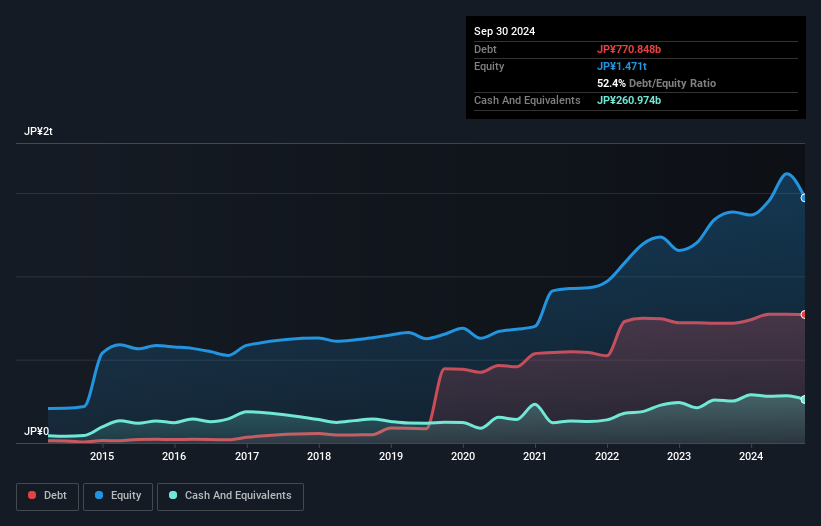Nippon Paint Holdings (TSE:4612) Has A Pretty Healthy Balance Sheet
Warren Buffett famously said, 'Volatility is far from synonymous with risk.' It's only natural to consider a company's balance sheet when you examine how risky it is, since debt is often involved when a business collapses. Importantly, Nippon Paint Holdings Co., Ltd. (TSE:4612) does carry debt. But should shareholders be worried about its use of debt?
When Is Debt A Problem?
Debt assists a business until the business has trouble paying it off, either with new capital or with free cash flow. If things get really bad, the lenders can take control of the business. While that is not too common, we often do see indebted companies permanently diluting shareholders because lenders force them to raise capital at a distressed price. By replacing dilution, though, debt can be an extremely good tool for businesses that need capital to invest in growth at high rates of return. When we examine debt levels, we first consider both cash and debt levels, together.
Check out our latest analysis for Nippon Paint Holdings
How Much Debt Does Nippon Paint Holdings Carry?
You can click the graphic below for the historical numbers, but it shows that as of September 2024 Nippon Paint Holdings had JP¥770.8b of debt, an increase on JP¥719.1b, over one year. However, it also had JP¥261.0b in cash, and so its net debt is JP¥509.9b.

A Look At Nippon Paint Holdings' Liabilities
According to the last reported balance sheet, Nippon Paint Holdings had liabilities of JP¥527.6b due within 12 months, and liabilities of JP¥903.1b due beyond 12 months. Offsetting this, it had JP¥261.0b in cash and JP¥412.0b in receivables that were due within 12 months. So it has liabilities totalling JP¥757.7b more than its cash and near-term receivables, combined.
Nippon Paint Holdings has a very large market capitalization of JP¥2.30t, so it could very likely raise cash to ameliorate its balance sheet, if the need arose. But it's clear that we should definitely closely examine whether it can manage its debt without dilution.
We use two main ratios to inform us about debt levels relative to earnings. The first is net debt divided by earnings before interest, tax, depreciation, and amortization (EBITDA), while the second is how many times its earnings before interest and tax (EBIT) covers its interest expense (or its interest cover, for short). The advantage of this approach is that we take into account both the absolute quantum of debt (with net debt to EBITDA) and the actual interest expenses associated with that debt (with its interest cover ratio).
Nippon Paint Holdings's net debt to EBITDA ratio of about 2.2 suggests only moderate use of debt. And its strong interest cover of 37.7 times, makes us even more comfortable. Nippon Paint Holdings grew its EBIT by 9.6% in the last year. Whilst that hardly knocks our socks off it is a positive when it comes to debt. The balance sheet is clearly the area to focus on when you are analysing debt. But ultimately the future profitability of the business will decide if Nippon Paint Holdings can strengthen its balance sheet over time. So if you're focused on the future you can check out this free report showing analyst profit forecasts.
Finally, while the tax-man may adore accounting profits, lenders only accept cold hard cash. So we clearly need to look at whether that EBIT is leading to corresponding free cash flow. Over the most recent three years, Nippon Paint Holdings recorded free cash flow worth 62% of its EBIT, which is around normal, given free cash flow excludes interest and tax. This free cash flow puts the company in a good position to pay down debt, when appropriate.
Our View
Happily, Nippon Paint Holdings's impressive interest cover implies it has the upper hand on its debt. And we also thought its conversion of EBIT to free cash flow was a positive. Looking at all the aforementioned factors together, it strikes us that Nippon Paint Holdings can handle its debt fairly comfortably. Of course, while this leverage can enhance returns on equity, it does bring more risk, so it's worth keeping an eye on this one. The balance sheet is clearly the area to focus on when you are analysing debt. However, not all investment risk resides within the balance sheet - far from it. These risks can be hard to spot. Every company has them, and we've spotted 1 warning sign for Nippon Paint Holdings you should know about.
If you're interested in investing in businesses that can grow profits without the burden of debt, then check out this free list of growing businesses that have net cash on the balance sheet.
Valuation is complex, but we're here to simplify it.
Discover if Nippon Paint Holdings might be undervalued or overvalued with our detailed analysis, featuring fair value estimates, potential risks, dividends, insider trades, and its financial condition.
Access Free AnalysisHave feedback on this article? Concerned about the content? Get in touch with us directly. Alternatively, email editorial-team (at) simplywallst.com.
This article by Simply Wall St is general in nature. We provide commentary based on historical data and analyst forecasts only using an unbiased methodology and our articles are not intended to be financial advice. It does not constitute a recommendation to buy or sell any stock, and does not take account of your objectives, or your financial situation. We aim to bring you long-term focused analysis driven by fundamental data. Note that our analysis may not factor in the latest price-sensitive company announcements or qualitative material. Simply Wall St has no position in any stocks mentioned.
About TSE:4612
Nippon Paint Holdings
Engages in the paints and fine chemicals businesses.
Undervalued with proven track record.
Similar Companies
Market Insights
Community Narratives



